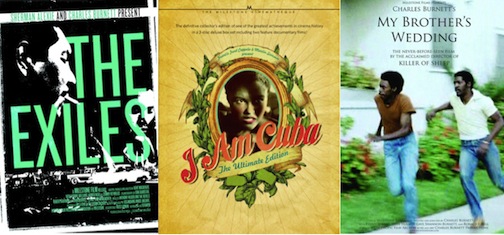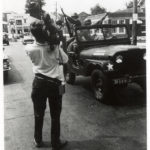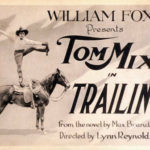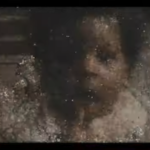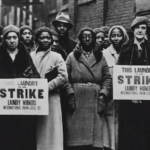Shirley Clarke Makes the Connection with Jason & Ornette
By Peter Monaghan
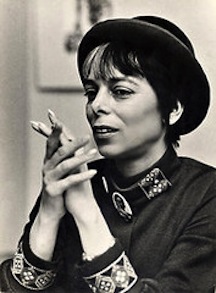
Shirley Clarke. Milestone Film.
Shirley Clarke suffered the neglect and disparagement that often visits upon great innovators.
“She helped inspire a new film movement and made urgently vibrant work that blurs fiction and nonfiction, only to be marginalized, written out of histories and dismissed as a dilettante,” Manhola Dargis wrote of her in the New York Times upon her death in 1997 at the age of 77.
But in recent years, and none too soon, efforts have been made to correct that all-too-common slight, particularly by Milestone Films.
The vaunted New Jersey-based restoration and reissue company is in the process of restoring, with collaborators like the Academy Film Archive and the UCLA Film & Television Archive, the large majority of Clarke’s films — it is well into its sequence of theatrical revivals, and next week [the last week of February 2015], it is releasing three of her major works on DVD and Blu-Ray for personal and institutional purchase and the rentals market.
The reissue specialist is well on the way in its “Project Shirley,” its five-year effort to restore and reissue most of Clarke’s work. In their Shirley Clarke Project, Doros and Heller have been collaborating with the Academy Film Archive and the UCLA Film & Television Archive to make outstanding DVD and Blu-ray disc packages with bonus items from the vaults such as extensive interviews with Clarke.
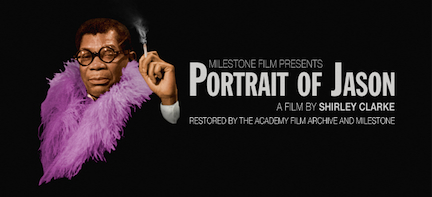 This month’s Milestone DVD/Blu-ray releases are Clarke’s depiction of jazz- and heroin-riddled junkies, The Connection (1962), as well as her portraits of two singular American cultural figures of the last 50 and more years: in Ornette: Made in America (1986), the jazz iconoclast Ornette Coleman, and in Portrait of Jason (1967), an unsung, riveting raconteur and cabaret performer, Jason Holliday, who in a film-long monologue relates his life of love, drugs, sex, and getting by.
This month’s Milestone DVD/Blu-ray releases are Clarke’s depiction of jazz- and heroin-riddled junkies, The Connection (1962), as well as her portraits of two singular American cultural figures of the last 50 and more years: in Ornette: Made in America (1986), the jazz iconoclast Ornette Coleman, and in Portrait of Jason (1967), an unsung, riveting raconteur and cabaret performer, Jason Holliday, who in a film-long monologue relates his life of love, drugs, sex, and getting by.
“I think that Shirley Clarke is as important as Orson Welles or… name any director,” says Dennis Doros, who in 1990 joined filmmaker Amy Heller in setting up Milestone and running it initially from their New York City one-room apartment. Since those first, scrabbling days, Milestone has brought new audiences, little by little, to films that revolutionized cinema craft even though many, upon first appearing, had been derided or, worse, ignored.
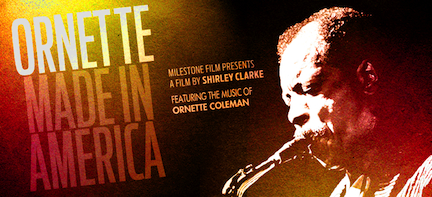 Milestone’s remit from the start has been to release masterpieces in American independent film, documentary film, and works “foreign” to the U.S., with whatever necessary restoration. The company can boast a broad top shelf of re-issues, among them Alfred Hitchcock’s Bon Voyage and Aventure Malgache, Charles Burnett’s Killer of Sheep, Kent Mackenzie’s The Exiles, Lionel Rogosin’s On the Bowery, Mikhail Kalatozov’s I Am Cuba, Marcel Ophuls’s The Sorrow and the Pity, and the Mariposa Film Group’s Word is Out. Last year it reissued Edward S. Curtis’s extraordinary 1914 film made among Kwakiutl people of the Pacific Northwest, In the Land of the Headhunters.
Milestone’s remit from the start has been to release masterpieces in American independent film, documentary film, and works “foreign” to the U.S., with whatever necessary restoration. The company can boast a broad top shelf of re-issues, among them Alfred Hitchcock’s Bon Voyage and Aventure Malgache, Charles Burnett’s Killer of Sheep, Kent Mackenzie’s The Exiles, Lionel Rogosin’s On the Bowery, Mikhail Kalatozov’s I Am Cuba, Marcel Ophuls’s The Sorrow and the Pity, and the Mariposa Film Group’s Word is Out. Last year it reissued Edward S. Curtis’s extraordinary 1914 film made among Kwakiutl people of the Pacific Northwest, In the Land of the Headhunters.
In Shirley Clarke, they have a project that is also an expression of faith in a filmmaker whom time almost passed by.
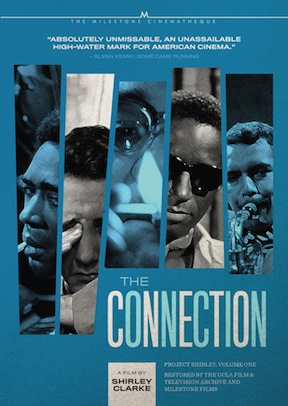 The Connection recreated a stage play by Jack Gelber that sharply divided audiences and critics when first released due to its depiction of junkies awaiting their connection in a New York flophouse. Clarke reframed the action of the play within a filmmaker’s attempts to film the junkies’ world, which she further peopled with a jazz combo that featured innovators Jackie McLean and Freddie Redd — both, ironically, barred from cabaret performances in New York due to drug charges.
The Connection recreated a stage play by Jack Gelber that sharply divided audiences and critics when first released due to its depiction of junkies awaiting their connection in a New York flophouse. Clarke reframed the action of the play within a filmmaker’s attempts to film the junkies’ world, which she further peopled with a jazz combo that featured innovators Jackie McLean and Freddie Redd — both, ironically, barred from cabaret performances in New York due to drug charges.
New York state film authorities refused Clarke’s film a commercial-screening license on the grounds of obscenity. Clarke successfully appealed to a state court, which overruled the censors but only after the film had opened in Manhattan anyway, in October 1962, without a license. It also showed at Cannes, although outside competition.
In Clarke’s 1967 black-and-white Portrait Of Jason, Jason Holliday, born Aaron Payne, is on screen throughout the film’s 107 minutes, which Clarke drew from 12 straight hours of filming beginning the evening of 3 December 1966. He proves extraordinarily compelling as he relates his life. His account is often hilarious, but also filled with pathos. He speaks of his childhood confrontations with his father while growing up in Trenton, New Jersey; of hustling to make his way into adult life; and of his career in nightclub entertainment at a time when homosexuality was outlawed in the United States.
Amy Heller at Milestone considers it likely Clarke’s “boldest and most influential film — and it is certainly one of her funniest, saddest, and most outrageous.” She adds: “The film is one of the very first LGBT films made, and one of the most honest and self-revealing.”
“Despite her kaleidoscope style,” noted ROVI’s Hal Erickson, “Clarke takes great pains not to editorialize: Jason is Jason, like it or not. While mainstream critics expressed nausea and disgust over Portrait of Jason, Swedish director Ingmar Bergman declared it to be ‘the most fascinating film I’ve ever seen.’”
To make her Ornette: Made in America, which she released in 1986, Clarke filmed the alto-sax great over three decades and also recreated scenes from his earlier boyhood in Fort Worth, Texas with two young actors playing Coleman: Demon Marshall and Gene Tatum.
Beginning in the 1960s, she followed Coleman and his then-young son, Denardo Coleman, who since his childhood has frequently worked as a drummer with his father. Clarke also filmed Ornette Coleman in New York city, Nigeria, and Morocco.
She ended her filming at a 1983 homecoming tribute concert in Fort Worth that featured Coleman’s “Skies of America” suite with John Giordano conducting the Fort Worth Symphony Orchestra, and a performance by his mighty Prime Time band.
With an unusual approach to constructing her hommage, Clarke sought to complement Coleman’s idiosyncratic style: early in his career, he freed his band members from jazz’s traditional insistence on structured meter, harmonics, and chord progression in favor of his “harmolodics,” which left band members largely to their own devices, to deal as they saw fit with traditional expectations of jazz structures and components.
He also set aside the saxophones constructed of brass that almost all exponents play, in favor of a white, molded-plastic one, distinctive in its tone just as Coleman always has been, anyway — his is a blues-drenched, yearning tone, often punctuated by whinnying squawks and a bucking motion.
New York Times jazz writer Nate Chinen greeted the Milestone release of Clarke’s portrait: “By virtue of the footage, alone, it’s a valuable time capsule for anyone drawn to Mr. Coleman’s work. … What nudges the film beyond archival value is a cadence and visual style proudly in tune with the music.”
Milestone’s release includes a 58-minute filmed interview with Clarke, as well as a booklet of Coleman reminiscences and a 32-minute interview with Denardo Coleman. The package’s 5-minute short by Clarke is a like a fancy restaurant’s amuse-bouche: it reflects her affection for Felix the Cat.
Vibing with Coleman’s music means proceeding idiosyncratically. Particularly early in his career, Coleman met dismissive and even hostile responses from fellow jazzmen. Clarke learned to expect a similar response, when she started out in film.
In 2009 the Edinburgh International Film Festival held a retrospective of Clarke’s work and issued this trailer:
As a grand-daughter of the inventor of the self-tapping screw and daughter of a successful entrepreneur, Clarke was raised amidst wealth but family trouble. She initially trained to be a modern dancer — for a time, with Martha Graham — but converted to film. She mused in 1955: “Why…shouldn’t a trained dancer, with an itching curiosity about movies, energy galore, and no experience, try her luck?”
She made some dance-related shorts, including Dance in the Sun in 1953, and Bullfight, with the dancer Anna Sokolow, which the Edinburgh and Venice Film Festivals honored with awards. In 1957, the New York Times named her A Moment in Love one the 10 best nontheatrical films of 1957. Next came a short, Skyscraper, which she made between 1958 and 1960 with two documentary-film makers, and it drew an Oscar nomination.
She was ready to complete her jump from dance to feature film, and did that memorably with The Connection (1962).
Clark set up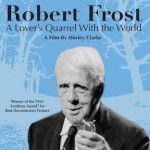 a film rental library, Film-Makers Cooperative, and won a 1963 Academy Award for best documentary feature for her Robert Frost: A Lover’s Quarrel with the World.
a film rental library, Film-Makers Cooperative, and won a 1963 Academy Award for best documentary feature for her Robert Frost: A Lover’s Quarrel with the World.
The Cool World (1963) received some art-house distribution, too, but again was not for everyone. Based on a novel by Warren Miller and starring actor Carl Lee, who had appeared in The Connection, it depicted a teenager’s efforts to acquire a gun in an attempt to take control of his life in a despairing, violent, gang-controlled Harlem slum.
The Connection and The Cool World, bluntly realistic, did not attract financial backing for Clarke’s next planned project. She built her own equity to make possible Portrait Of Jason.
Milestone’s resuscitation of Jason is particularly welcome. It showed a few times in New York, back in 1967, but in recent years was thought to survive only in some ill-used prints and edited versions. Doros scoured the globe for better elements, and eventually was rewarded.
In 2012, as Project Shirley began to issue new prints for theatrical release, the New York Times’ Manhola Dargis detailed her surprising life as “dancer, bride, runaway wife, radical filmmaker, and pioneer.” Dargis wrote: “Her story is complex and contradictory and her life shot through with strange fissures,” he wrote. She was “a woman working in a predominantly male world, a white director who turned her camera on black subjects, she was a Park Avenue rich girl who willed herself to become a dancer and a filmmaker, ran away to bohemia, hung out with the Beats and held to her own vision in triumph and defeat. She helped inspire a new film movement and made urgently vibrant work that blurs fiction and nonfiction, only to be marginalized.”
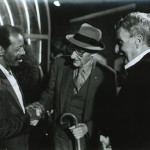
Ornette Coleman meets William S. Burroughs during the filming of “Ornette: Made in America.” Milestone FIlm.
Doros and Heller, in typical fashion, set out these and later parts of Clarke’s life in detail on Milestone’s website. The amount of material they post there demonstrates how driven they are by fascination with their subjects, and passion for them is evident on their website. They make sure that most purchasers and viewers of their film reissues don’t need to hunt high and low, themselves.
For all their activities over the years, Heller and Doros have been honored many times. In 2012, for example, Milestone became the first two-time winner of the prestigious New York Film Critics’ Circle’s Special Award, for its Shirley Clarke project.
Doros shares the kudos with its collaborators over the years, including several in its Clarke revival, including UCLA Film & Television Archive, Academy Film Archive, and Modern Videofilm. Says Doros: “We tend to work with the guys that are our friends, that we like working with.” That was a wide circle even before Doros’s recently completed six-year stint on the board of directors of the Association of Moving Image Archivists.
For Ornette: Made in America, sound was of course crucial, and the securing of the best possible outcomes fell to John Polito, the owner and chief engineer of Audio Mechanics, in Burbank, Calif. “I recall the biggest challenge was bringing out the clarity of the live music performances,” he says. “Ross Lipman, the supervisor for the restoration, and I spent quite a bit of time fussing over the equalization and noise reduction settings to optimize them” (see accompanying article).
Even by Milestone’s ambitious standards, trying to issue next to all Shirley Clarke’s work is a reach. Why her?
“The answer is, Why not?” says Doros. Particularly once he and Heller, in league with filmmaker Steven Soderbergh and Turner Classic Movies, issued Charles Burnett’s Killer of Sheep in 2007, he says, “we started thinking about post-war American independents, and we were fascinated with the idea of films that bordered between documentary and fiction.
“So we did The Exiles (in 2008), Araya from Venezuela, (in 2009) Charles Burnett’s My Brother’s Wedding (2007) which is based on real life, and a couple more.
“We were fascinated with this territory and also with films that have been forgotten by film academics, and film critics — by film history, really.
“Shirley Clarke had been on our minds for a while, but I thought she was too popular because while I was growing up she was a pretty major director. But I started asking around, and nobody knew who she was, and nobody had seen her films, and I realized that to me she was known but to almost everybody else, she was forgotten.”
He found that very little had been written about her. “We were fascinated by the idea she had been lost; she had been forgotten.”
He discovered that the DVDs that were on the market “could be a lot better.” The Connection, for example, was just a copy from a VHS release of 20 years before.
He noticed something strange in an existing Portrait of Jason DVD release: It looked good at first, but he soon noticed “it was missing four or five minutes. There are sections of the film that are shot over black leader and the characters keep talking. I realized that whoever was the engineer had just cut out the black leader film” and patched the audio around what remained.
Reissues seemed called for. So, he says, “one morning I turned to Amy and said, ‘How about Shirley Clarke?’ and she said, ‘Yeah, let’s do it.’
“It’s really that easy, when you’re a small company.”
He did not envisage at that early date that a project to reissue Shirley Clarke films would turn into what he now characterizes as “a six-year odyssey.” He and Heller began acquiring Clarke’s films, many from her daughter Wendy Clarke, also a filmmaker. They got rights to reissue the Ornette Coleman film from Katheryn Hoffman Gray, its original producer.
Some films took a year or two to get rights to. Among complications was that the University of Wisconsin Center for Film and Theater Research turned out to hold far more Clarke material than Doros had realized.
And, something else quite strange, something that restoration specialists like Doros and Heller rarely experience: They got the material they had been promised, says Doros: “All the half-inch videos, the 16mm, all the outtakes, the unfinished work…”
The only exception was The Cool World, whose copyright holder has expressed interest in producing his own reissue.
The final, fourth volume of Milestone’s Shirley Clarke project is being shaped, now. Doros calls it “the magic box.” Its three or more discs will have Robert Frost: A Lover’s Quarrel with the World, several short films, Clarke’s home movies, outtakes, unfinished work, “things that nobody had ever seen before, a lot of it,” says Doros.
A business like Milestone, small compared to other major players in distribution of restored and reissued titles, enjoys plusses and minuses. The latter: tight budgets, little security; the former: in the American market, if people of eclectic but judicious tastes like Doros and Heller like something, it’s a fairly safe bet that the country’s enormous, affluent population will provide plenty more.
What, then, might be the prospects for the Shirley Clarke material?
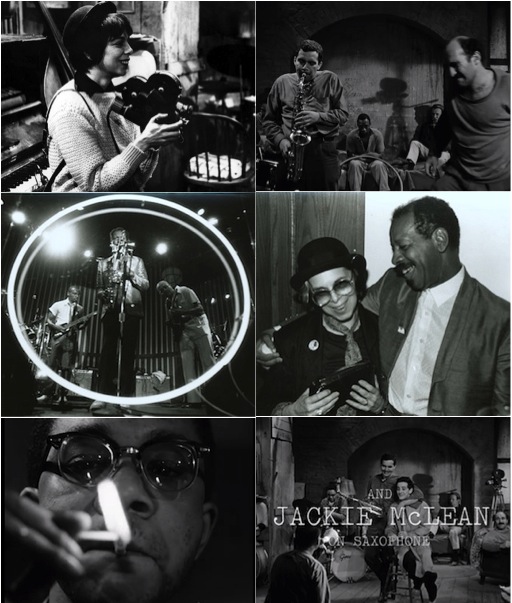
Scenes from Shirley Clarke’s films and filming. From top left: Clarke on the set of “The Connection” and a scene from it; Ornette Coleman with Clarke; two scenes from “The Connection,” and Coleman with his members of his Prime Time band in “Ornette: Made in America.” Images: Milestone Film and Video.
n
Doros is optimistic. Even though he’s worked on the project for six years, “I keep finding new things in the films,” he says. “That doesn’t always happen. I have fallen in love with the most obscure material in her collection,” such as idiosyncratic films Clarke made with dancer/choreographer Anna Sokolow “whom I’d always loved before I knew who Shirley Clarke was.”
To try to limit Volume 4 to a manageable size, Doros has sent samplers to friends, “so they can tell me whether I’ve gone overboard. I don’t know where to stop. I haven’t stopped. We’ve spent a fortune on digitizing the collection.”
He’ll probably settle for putting some material online, only, but perhaps not. Clarke’s home movies? “Her wedding, her honeymoon, her visit to [sister] Wendy’s camp where Shirley and her friends visit her. I’m thinking, if I had all this for Orson Welles, this would be the most amazing thing to cinephiles. And I think that Shirley Clarke is as important as Orson Welles.
“So I’m thinking of this as Everything You Want to Know about Shirley Clarke, and it’s going deeper into a filmmaker’s career than has ever been done before.”
He reflects a moment; adds: “I skipped a 1927 New Jersey baby parade because that’s actually about her sister.”
n
But he had already determined to include a 25-minute compilation of childhood home movies Clarke made, along with numerous family photos he scanned as DVD extras. “As I say,” he observes, “if you name another director like Kubrick, people would say: ‘Oh, you have Kubrick’s baby photos and home movie reels?’ I’m hoping they’ll say the same about Shirley.”
Again, he pauses a moment, then adds: “I’d be less interested in doing Orson Welles like this, just because it’s not as much fun for me to learn what everybody else has written about someone.”
“I don’t know if there’s a market,” he continues. “Everybody asks, ‘How’s business?’ And I say ‘I’ll find out in two years, after the theatrical release, after the DVD release, after it comes out on Turner Classic Movies.”
It’s only the two of us; we don’t have a staff; we work out of the house… So we can take these risks but we can’t do things forever that way. I suspect these will work. There is also a new biography coming out by Larry Kardish” [with working title “Shirley Clarke: The Original Chelsea Girl]. And we’re producing a documentary about Shirley because we have all the material.
“We’ll see what happens.”
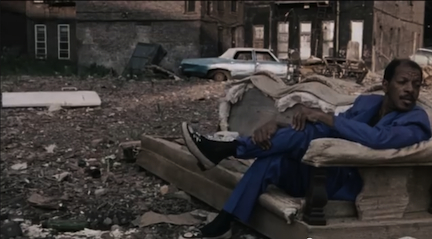
Ornette Coleman; still from “Ornette: Made in America.”
Previous Post: Sticking Up for East German Film

